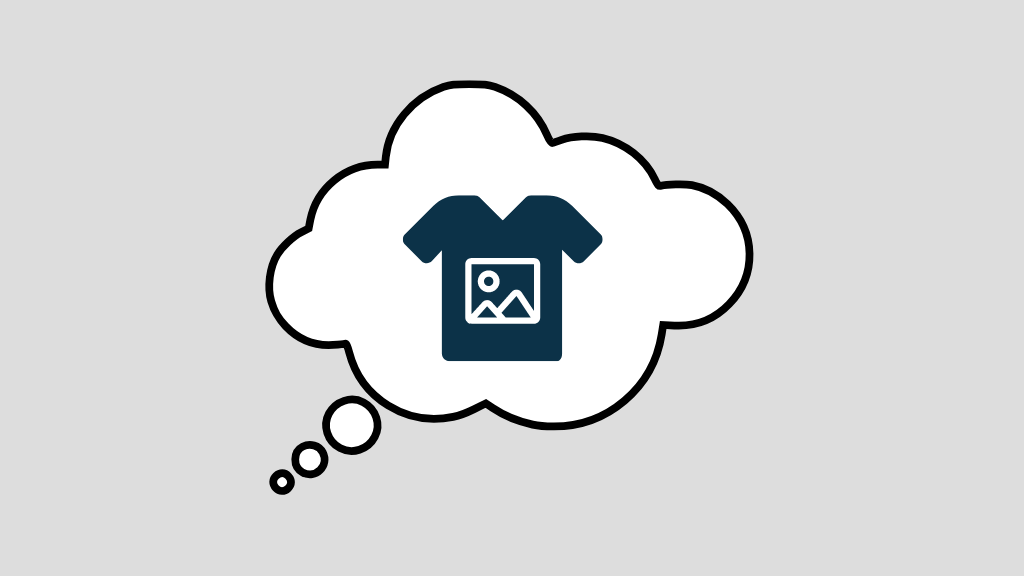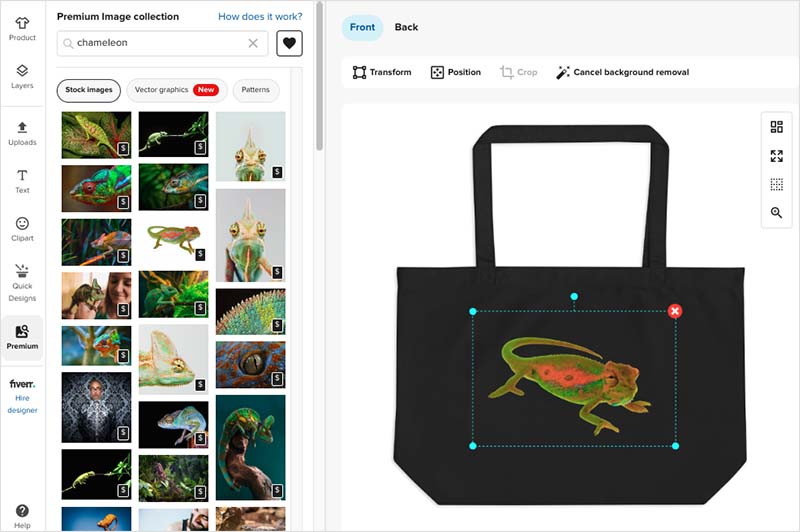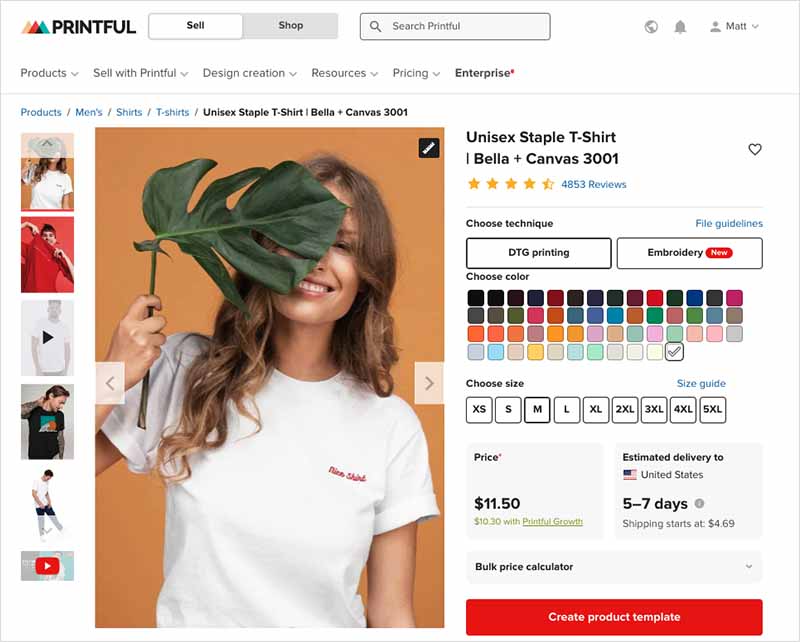
If you’re considering starting a brand new POD business, this ‘What is Print on Demand?’ guide is for you. In it I delve into this exciting online business model, exploring its benefits, drawbacks and how to get started with it.
Let’s start off with a simple definition of print on demand.
Print on demand: a definition
Print on Demand — widely known as POD — is a business model where products are only made (or ‘printed’) once an order has been placed. This differs significantly from traditional approaches to selling goods, where companies manufacture and store products in large quantities hoping they’ll sell.
The print-on-demand process starts when a customer places an order for a product on an online store. This order is then sent to the POD service provider, which then prints the design on the product and ships it to the customer.
The beauty of it all is that the owner of the online store where the process all began never needs to hold their own inventory or get involved with the shipping process at all. This makes it a low-cost, low-risk way to start a business.
The history of print on demand
Print on demand has revolutionized various industries by changing how products are created, sold and delivered.
But it’s not as new as you might think. The roots of the modern-day print-on-demand industry can arguably be traced back to the1960s, when an inventor called Michael Vasilantone invented a screen printing device that revolutionized screen printing. Appropriately named the ‘The Vasilantone,’ it made screen printing incredibly quick — one-of-a-kind designs became simple to produce and sell.

Since then, and especially with the advances in digital printing technology, the concept of creating customized printed items has taken the world by storm. And the print-on-demand model has expanded far beyond screen printing: nowadays POD can be used to design and sell a very wide range of products, including books, clothing, phone cases, home decor, wall art and much more.
Benefits of the print-on-demand business model
Some of the key benefits of print on demand are as follows:
Cost effectiveness
One of the most significant advantages of POD is its cost-effectiveness. Traditional businesses often face high upfront costs associated with product manufacturing and storage. However, with POD, you don’t have to invest in a bulk inventory that might not sell — and this significantly reduces the capital required to start and run a business (making it a great model for a side hustle in the process).
Simplified inventory management
In traditional business models, managing inventory can be a complex and time-consuming task. With POD however, these complications are eliminated, as you don’t need to hold any inventory. Products are only created when a customer orders them, so there’s no risk of accumulating unsold stock or wasting resources on storage.
Customization options
A fantastic benefit of POD is the high level of customization it allows. The business model enables businesses to offer a broad range of unique designs and products without the associated risk of producing diverse stock in advance. The sophisticated printing technology used in POD allows complex and colorful designs to be printed with ease, and allows for high-quality customization.

Sustainability
By only producing what is needed, POD can contribute to sustainability efforts (by reducing waste associated with unsold products). Done well, it can be an environmentally-conscious model.
The drawbacks of print on demand
The most significant drawbacks of POD to consider are:
Long production and shipping times
A key challenge that many POD businesses face is long production and shipping times. Since products are created upon order, it can take quite a few days before a POD product actually reaches the customer. POD businesses typically face slower delivery times than those enjoyed by businesses with ‘ready-to-ship’ inventory.
(This is an issue the introduction of ultra fast delivery services like Amazon Prime, modern consumers’ expectations around delivery times can be quite high).
Quality control
Quality control in POD can also be a challenge, as POD business owners don’t control the manufacturing process. This can potentially lead to inconsistencies in product quality, which can in turn negatively affect customer satisfaction and business reputation.
Product limitations
While POD can be used to sell an increasingly wide range of products, there are still limitations to what can be produced. Some products might not be suitable for the print-on-demand model due to complex manufacturing processes, or the materials involved being incompatible with POD printing technology.
Low profit margins
The cost per unit for print-on-demand products tends to be higher than those that are manufactured in bulk. Higher product costs necessitate higher retail prices, hampering the competitiveness of your product pricing.
And, depending on how far away your customers are from the facility producing your demands, you may have high shipping costs to contend with too.
And all this can lead to lower profit margins.
Ethical concerns
POD it is not without ethical considerations. A key concern lies in the production process: since business owners often don’t oversee production firsthand, ensuring fair labor practices can be challenging. The potential for intellectual property rights violations is another issue — the ease of uploading designs to POD platforms often leads to unauthorized use of copyrighted or trademarked material.
And, while POD can reduce material waste, the environmental impact of shipping individual products instead of bulk shipments is a concern.
Ok, so those are some of the pros and cons of print on demand. But how do you actually get started with it?
How to get started with Print on Demand
Here are the key steps you should follow when setting up a print-on-demand business:
1. Find a niche
Finding a profitable niche is key to the success of any print-on-demand business. And to identify one, you’ll need to conduct thorough market research — the aim of this being to understand or spot consumer trends, popular product categories and under-served markets.
You can use tools like Google Trends, social media, and platforms like Etsy or Amazon to find popular themes or products; and keyword research tools like Ahrefs and Semrush can give you valuable insights into what products people are actually searching for online.
The idea behind all this research is to identify gaps that your new POD business could fill.
(Consider the logistical aspects as well — some products might be more suited to POD than others.)
📚 Key resource: How to do keyword research
2. Choose a print-on-demand provider
Your choice of POD service provider is crucial to the quality of your products and the smooth operation of your business — and it’s important to pick the right one.
Popular print-on-demand suppliers include Printful, Printify, Gooten, AOP+ and TeeSpring (Spring) — but some of these are considerably better than others.
When choosing a supplier, consider factors like product range, product costs, print quality, shipping and the type of ecommerce platforms that the POD supplier supports.
📚 Related resource: Printful vs Printify
3. Design creation
Creating appealing designs is at the heart of a POD business.
Most of the print-on-demand services mentioned above give you simple drag and drop editors to create designs with — these let you upload images and text, lay elements out to suit your requirements and apply the finished design to a wide range of products.

Your designs can be self-created, or alternatively, you can hire a professional designer to work on them. But either way, make sure the designs are high in quality, and align with your brand image and the preferences of your target audience.
4. Set up your online store
Once you’ve chosen a print on demand supplier and have some products to sell, it’s time to showcase and sell them! This usually involves creating an online store.
Platforms like Shopify, BigCommerce, Wix and WooCommerce are good options here — they offer user-friendly interfaces and can be easily integrated with most of the major POD services
ℹ️ Recommended platform for print-on-demand: Shopify
If you’re interested in starting a print-on-demand business, we’d suggest doing so with Shopify. It’s an ecommerce platform that works with all the major POD apps, comes with a wide range of attractive themes and is very easy to use.
It also lets you access a wide range of marketing tools and apps that let you promote your ecommerce store and print-on-demand products easily.
5. Market your products
Effective marketing can make or break a POD store. To ensure yours is a success, you’ll need to use a wide range of promotional tactics including:
- search engine optimization (SEO)
- blogging
- social media marketing
- email marketing
- online PR
- online advertising.
And that’s it! You’ve started a brand new print-on-demand business.
📚 Additional resources to help you with print on demand
We hope you’ve found this introduction to print on demand helpful. We have a few other resources that you may wish to check out that may help you start a print-on-demand business or successful ecommerce site:
No comments